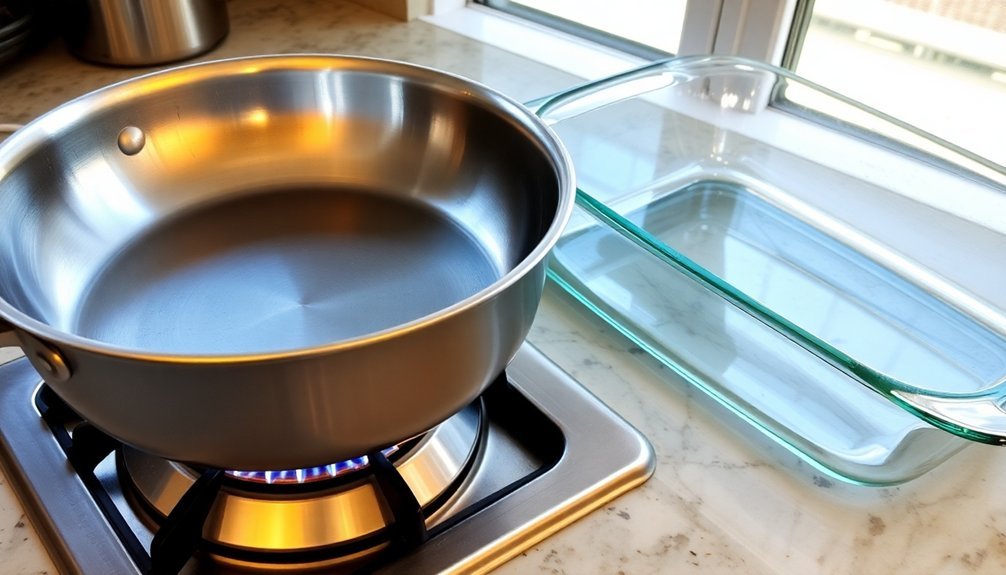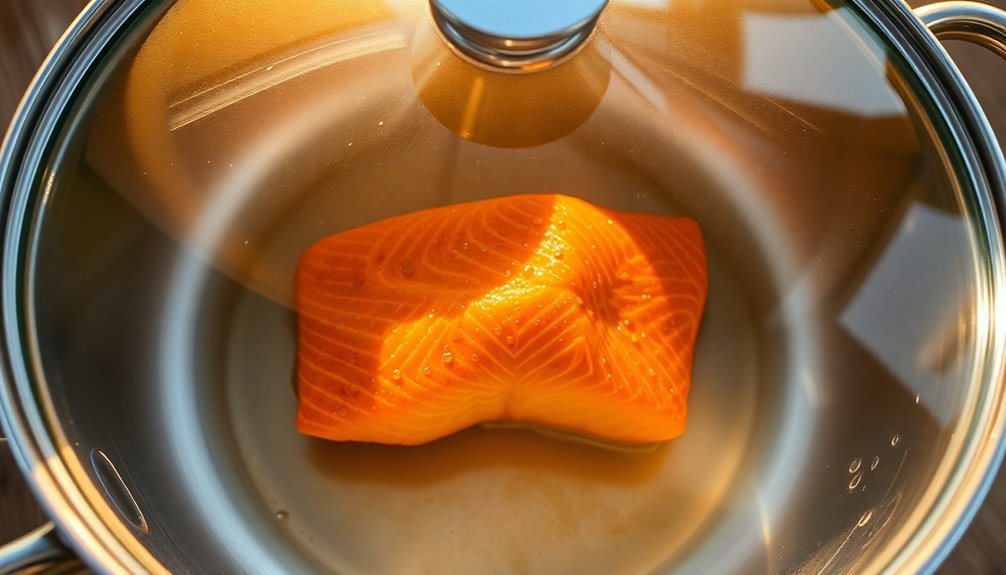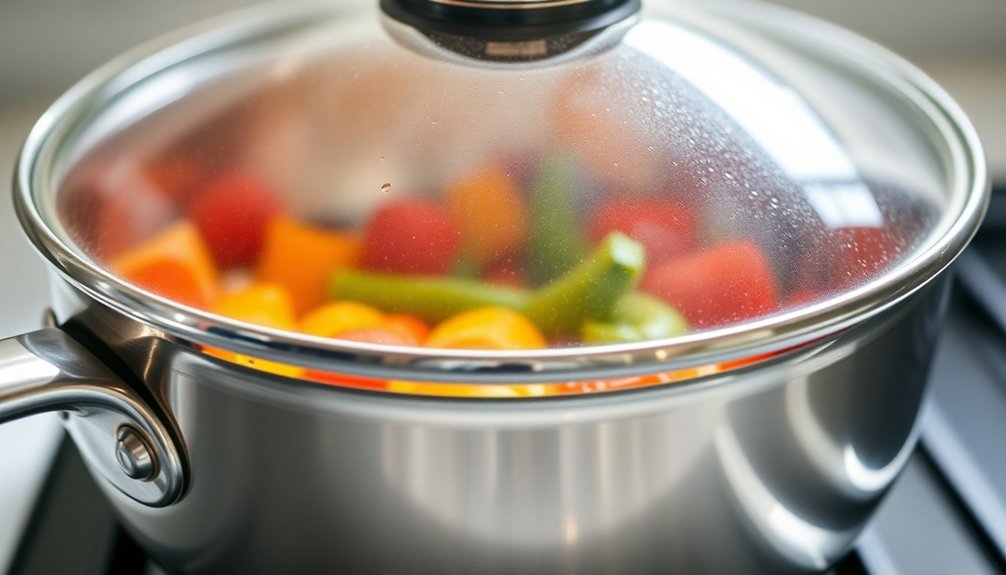Glass and stainless steel are your best choices for heat-based cooking because they're both non-reactive and won't leach harmful chemicals into your food at high temperatures. You'll find glass excels at maintaining stable temperatures and lets you monitor food without opening lids, while stainless steel offers superior heat distribution and quick temperature adjustments. Both materials resist corrosion, stand up to aggressive cleaning, and work well for solar cooking applications. They're also environmentally friendly and durable enough to last for years. The more you understand their unique properties, the better equipped you'll be to maximize their benefits in your kitchen.
Thermal Properties Matter

Three key thermal properties define how glass and stainless steel perform in the kitchen: conductivity, heat capacity, and heat distribution.
You'll notice both materials have lower thermal conductivity than copper or aluminum, which means they heat up more slowly and distribute heat less evenly on their own.
However, this isn't always a disadvantage. Glass's high heat capacity makes it excellent for maintaining stable temperatures, especially in oven cooking. A glass casserole needs 3.27 times more energy than an aluminum pan to reach the same temperature.
While stainless steel has a lower heat capacity, manufacturers often enhance its performance by adding copper or aluminum layers to improve heat distribution.
This cladding technique gives you the best of both worlds – stainless steel's durability combined with copper or aluminum's superior heat conductivity.
The result is cookware that delivers even heating while maintaining the benefits of each material.
Safe Cooking Vessel Selection
When you're looking for safe cooking vessels, glass and stainless steel offer superior heat distribution that helps prevent hot spots and burning.
You'll benefit from these materials' inherent safety features, including their non-reactive surfaces that won't leach chemicals into your food even at high temperatures.
Their excellent temperature control properties let you maintain precise cooking conditions while protecting your health and enhancing your culinary results. High-quality options featuring 18/10 stainless steel provide exceptional durability and corrosion resistance for long-lasting performance.
Heat Distribution Benefits
Selecting cookware with excellent heat distribution properties stands as an important factor in achieving safe and consistent cooking results.
You'll find stainless steel notably outperforms glass in this vital aspect. While glass struggles with heat conductivity and often creates hot spots, stainless steel guarantees even heating across your cooking surface.
Stainless steel's multi-layered construction, often incorporating aluminum or copper cores, provides superior thermal diffusivity. This means you'll experience more uniform cooking temperatures, preventing undercooked or burnt areas in your food.
It's particularly effective when preparing dishes that require consistent heat, like stir-fries or curries. The fully clad design in quality stainless steel cookware ensures heat travels evenly up the sides of the vessel, not just across the bottom. You'll also benefit from lower energy costs since stainless steel's efficient heat distribution requires less power to maintain desired temperatures.
Plus, its durability and resistance to thermal shock make it a safer choice for daily cooking.
Material Safety Features
Safe cooking starts with understanding the inherent properties of your cookware materials. When you choose glass and stainless steel, you'll avoid harmful chemicals like PFAS, PTFE, BPA, and phthalates that can leach into your food. Both materials are non-toxic and non-reactive, ensuring your meals remain pure and uncontaminated.
| Safety Feature | Glass | Stainless Steel |
|---|---|---|
| Chemical Leaching | None | Minimal to none |
| Heat Safety | No toxic release | No toxic release |
| Food Interaction | Inert | Non-reactive |
These materials align with sustainable practices while prioritizing your health. Glass remains completely inert, making it ideal for acidic foods, while high-grade stainless steel resists corrosion and bacterial growth. You'll also benefit from their transparency in manufacturing, as both materials are strictly regulated and recyclable.
Temperature Control Advantages
Temperature control plays an essential role in your cooking success, making the choice between glass and stainless steel vessels particularly important.
You'll find that glass cookware excels in oven use but falls short on the stovetop due to its poor heat distribution and slow response to temperature changes. It's prone to hot spots and won't give you the precise control needed for delicate dishes.
In contrast, stainless steel offers better temperature stability once preheated, making it ideal for tasks requiring consistent heat like sauce-making.
While it's not the fastest conductor, you'll get more reliable results than glass on the stovetop. When you need to adjust temperatures quickly, stainless steel responds more effectively, though you'll want to preheat it properly to avoid hot spots and guarantee even cooking.
Heat Distribution Excellence

When you're choosing between glass and stainless steel cookware, you'll notice significant differences in how they handle heat distribution and temperature control.
Stainless steel, especially with multi-ply construction incorporating aluminum or copper layers, offers superior heat conductivity and even cooking across the surface, making it ideal for precise temperature control on stovetops.
Glass cookware, while slower to heat up, excels at maintaining consistent temperatures and retaining heat longer, making it particularly suitable for oven baking and serving dishes that benefit from gradual, steady cooking.
Even Cooking Performance
Since achieving consistent cooking results depends heavily on heat distribution, understanding how different materials handle thermal energy is essential.
You'll find that stainless steel cookware with multi-layered construction offers superior performance, especially when it includes aluminum or copper cores for ideal heat conduction.
To maximize even cooking performance, you'll want to match your pan size to your burner and preheat to around 225°F before adding food.
When you're working with larger pans, consider rotating them occasionally to compensate for hot spots, particularly on electric ranges.
You'll achieve the best results by placing ingredients in a circular pattern and maintaining slight movement during cooking.
These techniques, combined with proper heat management, will help you achieve that perfect sear and guarantee your food cooks uniformly without burning.
Temperature Control Benefits
Professional chefs and home cooks alike will appreciate the remarkable temperature control that modern glass and stainless steel cookware provides.
You'll enjoy precise heat adjustments from 1 to 100% power, allowing you to quickly shift from a rapid boil to a gentle simmer with just a turn of the control knob.
The advanced temperature control probe helps you maintain consistent cooking temperatures for stocks and sauces without worrying about boil-overs.
You'll benefit from the industry-leading 93% efficiency rating, which means more heat goes directly into your cooking rather than being lost to the surrounding environment.
Plus, these materials work seamlessly across multiple cooking surfaces – from induction to gas – while providing superior heat distribution.
With oven-safe capabilities and ergonomic handles, you'll have complete control over your cooking process.
Material Durability Under Sun
Understanding the durability of cooking materials under sun exposure is essential before investing in either glass or stainless steel cookware.
You'll find both materials excel in UV resistance, though in different ways. Stainless steel actually benefits from UV exposure, as it can enhance its pitting resistance and slow corrosion rates.
Glass remains chemically inert and won't degrade under UV light, maintaining its clarity and strength.
When it comes to longevity, stainless steel won't rust, stain, or absorb odors, even in harsh environments. It withstands mechanical shocks and aggressive cleaning.
Similarly, glass maintains its durability and chemical resistance over time, resisting both acidic and alkaline substances.
You can confidently store either material in sunny spots, knowing they'll retain their properties and performance without deterioration.
Energy Efficient Container Choices

When selecting energy-efficient containers for cooking, you'll discover considerable differences between glass and stainless steel options.
Glass containers excel at maintaining consistent temperatures and allow you to monitor your food without opening lids. Their non-porous nature helps retain heat effectively, and they're versatile enough to go from freezer to oven.
Stainless steel offers distinct advantages through rapid heating and cooling, making it ideal for pressure cooking and passive cooking methods. You'll save energy by matching your container's bottom diameter to your cooking zone and using tight-fitting lids.
For maximum efficiency, look for stainless steel cookware with encapsulated bottom technology.
To optimize energy use, consider using stackable containers, cooking with less water, and preparing one-pot meals. These practices, combined with proper container selection, will considerably reduce your energy consumption.
Practical Benefits When Solar Cooking
Solar cooking goes beyond energy efficiency to offer remarkable health and environmental advantages.
You'll breathe cleaner air since there's no smoke from traditional cooking fires, and you won't risk burns from open flames. The sun's free energy helps you save money while preventing deforestation and reducing CO2 emissions.
When you use glass and stainless containers in your solar cooker, you'll maintain temperatures between 250°F and 350°F, perfect for baking, boiling, steaming, or roasting.
Like a slow cooker, your meals need minimal attention while cooking. You'll appreciate how these durable materials help pasteurize drinking water and cook food safely.
Best of all, you're reducing indoor heat during summer months, cutting electricity costs, and supporting sustainable cooking practices that benefit both your household and the environment.
Frequently Asked Questions
Can Glass and Stainless Steel Cookware Be Used on Induction Cooktops?
You can't use glass cookware on induction cooktops since it's non-magnetic. For stainless steel, you'll need magnetic-grade varieties – test with a magnet. If it sticks to the bottom, you're good to go.
How Do Extreme Temperature Changes Affect These Materials During Cooking?
You'll find glass can crack under sudden temperature changes, while stainless steel remains stable. Glass needs gradual heating and cooling, but your stainless cookware can handle rapid temperature shifts without damage.
Which Material Is Better for Cooking Acidic Foods Like Tomato Sauce?
You'll find glass cookware is your best choice for acidic foods like tomato sauce since it's completely non-reactive. While high-quality stainless steel works too, glass eliminates any risk of metal leaching into your food.
Are There Specific Cleaning Products to Avoid With Glass Cookware?
You'll want to avoid harsh chemicals, oven cleaners with lye, scrubbing sponges, and wire wool pads. Don't use your dishwasher either, as it can etch the glass surface over time.
What Causes Stainless Steel Cookware to Develop Rainbow Discoloration Over Time?
Your stainless steel develops rainbow discoloration when heat causes chromium to react with oxygen, forming a thin oxide layer. While it's purely cosmetic, you'll notice this happens more with higher cooking temperatures.
In Summary
You'll find glass and stainless steel containers are your best allies for heat-based cooking. They're durable, distribute heat evenly, and won't leach harmful chemicals into your food. When you're using solar or conventional cooking methods, these materials maintain steady temperatures and won't warp or degrade. They're easy to clean, long-lasting, and energy-efficient – making them worth your investment for safe, reliable cooking results.





Leave a Reply